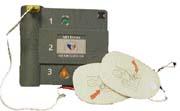
I am writing to make the Lawrence Community aware of a decision that effects everyone’s life on the Lawrence campus.129,931 American’s have died this year from Sudden Cardiac Arrest (SCA). 54, 570 could have been saved by early defibrillation with an Automatic External Defibrillator (AED).
A common misconception about SCA is that it is only a problem for senior citizen males. This, unfortunately, is not the case.
SCA has struck both men and women in their teens, 20’s, 30’s, and 40’s. Sergei Grinkov and Hank Gathens are both prime examples of how SCA can strike very healthy young people.
SCA is mostly commonly caused by an electrical disturbance called ventricular fibrillation, where the heart goes into rapid quivers of electrical pulses that prevent the heart from pumping blood. The only way to stop ventricular fibrillation and SCA is with an AED.
These fairly new computerized portable machines send electrical charges through the chest to shock the heart back into a normal blood pumping rhythm. Without the use of an AED a person who is suffering from SCA will eventually completely cease to have a heart rhythm and will be dead.
The heart usually stops within 5 minutes of going into SCA, so in order for an AED to be useful, it must be used within the first five minutes of someone experiencing problems.
With all this in mind, I set out to make AEDs accessible to everyone on Lawrence’s campus. I started out by doing research with a local hospital on inquiring which types of AEDs would be better than others. I then made contacts with manufactures and had specialists come to our campus to determine where placement would be most effective.
Because the AEDs must be used within the first five minutes of someone going into SCA, the specialist decided that one per building would allow for one to be accessible from all points on campus in under five minutes. This decision was made after doing a walk through on campus, when it was determined that it would not be feasible to have only a few AEDs in centralized locations because the time to gain access to one of the AEDs would be to great.
The total cost for twenty-three AEDs and all the equipment necessary to hold them came to around $75,000. After all of my research and findings, I took all of my information to the administration in early winter.
In early spring, I learned that Lawrence decided that AEDs were needed on the campus, but instead of buying the twenty-three, they decided on buying just one. This one AED will be carried around in the security vehicle.
After strong objections on my part, asking who they where going to be effective and used under five minutes, the LU administration guaranteed me that the LU security had a response time of under three minutes anywhere on campus. They also said that one AED was more affordable than twenty-three.
So here are my questions to the LU community: Do you feel safe knowing that Lawrence has rejected the recommendations of a specialist by saying that one AED is enough? Do you really trust security with your life? Do you really believe that security can be on the fourth floor of Colman and make it to the fourth floor of Trevor in their golf cart in under three minutes?
Do you really like the fact that Lawrence has put a price of your life, by saying that $75,000 is too much to spend to prevent future deaths? Give administration a call and express your concerns. It is your life we are talking about.
To learn more about AED’s visit the following website: www.padl.org
